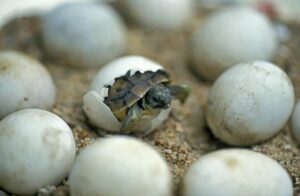Frequently, interest piques regarding turtle reproductive habits, sparking inquiries such as ‘Do male turtles lay eggs?’ Delving into this question unveils the captivating complexities of turtle biology and behavior.
No, male turtles do not lay eggs. In most turtle species, including males, only females have the physiological capability to produce eggs and lay them. Male turtles contribute to reproduction by fertilizing the eggs through copulation with females.
Understanding Turtle Reproduction

Turtles have fascinating reproductive strategies that vary among species but generally follow a similar pattern. Here’s an overview:
- Sexual Dimorphism: Many turtle species exhibit sexual dimorphism, where males and females have different physical characteristics. In some species, males have longer tails, thicker claws, or brighter colors than females.
- Courtship: Courtship behaviors vary widely among species but often involve visual displays, vocalizations, or physical interactions. Males may compete for females, and females choose mates based on various factors such as size, health, and vigor.
- Mating: Turtles typically mate in the water, although some species mate on land. Mating usually involves the male mounting the female and clasping her shell with his claws or biting her neck to maintain position.
- Internal Fertilization: Turtles have internal fertilization, where the male deposits sperm into the female’s reproductive tract. The sperm fertilizes the eggs inside the female’s body.
- Egg Development: After fertilization, the female develops eggs within her body. The development period varies among species but can range from a few weeks to several months.
- Egg Deposition: Once the eggs are fully developed, the female seeks out a suitable nesting site, typically sandy beaches or soil near water bodies. She digs a nest with her hind limbs and deposits the eggs into the hole.
- Incubation: The eggs are left buried in the nest, where they undergo incubation. Incubation periods vary depending on factors like temperature and humidity but generally last several weeks to a few months.
- Hatchling Emergence: When the eggs hatch, the hatchlings use their egg tooth, a small projection on their snout, to break out of the eggshell. They then dig their way to the surface and make their way to the water.
- Independent Life: Once in the water, hatchlings are largely independent and must fend for themselves. They face numerous challenges, including predation, habitat loss, and environmental pollution.
- Sex Determination: In many turtle species, including most sea turtles, the temperature at which the eggs are incubated determines the sex of the offspring. This phenomenon, known as temperature-dependent sex determination (TSD), plays a crucial role in the conservation of turtle populations.
Understanding turtle reproduction is essential for conservation efforts, as many turtle species face threats such as habitat destruction, pollution, climate change, and overexploitation. By protecting nesting sites, reducing human-induced disturbances, and implementing conservation measures, we can help ensure the survival of these fascinating creatures.
key differences in anatomy between male and female turtles
The anatomy of male and female turtles exhibits several key differences, many of which are related to their reproductive roles and behaviors. Here are some notable distinctions:
- Tail Length and Thickness: In many turtle species, males typically have longer and thicker tails compared to females. The tail difference often reflects the need for males to use their tails during mating to maintain grip on the female’s shell.
- Claw Size and Shape: Males may have larger and more robust claws than females, particularly on their front limbs. These claws are used during courtship and mating, where males may grasp or stroke the female’s shell.
- Cloacal Opening: The cloacal opening, which serves as the exit point for waste and reproductive products, may differ between males and females. In males, the cloacal opening is positioned farther away from the body and may protrude slightly, while in females, it is usually closer to the body and less prominent.
- Plastron Shape: The plastron, or the bottom part of the shell, can exhibit differences between male and female turtles, particularly in species where males have a concave plastron. This concavity allows males to mount females more easily during mating.
- Body Size and Shape: In some turtle species, males are larger than females, while in others, females are larger. These size differences can be related to factors such as mate competition, reproductive strategies, and ecological roles within their habitats.
- Secondary Sexual Characteristics: Some turtle species exhibit secondary sexual characteristics, such as coloration patterns or ornaments, that are more pronounced in males than females. These features are often used in courtship displays and mate attraction.
- Reproductive Organs: Internally, male turtles possess reproductive organs such as testes and a penis or hemipenis for sperm transfer, while females have ovaries and a reproductive tract for egg development and fertilization.
These anatomical differences between male and female turtles are adaptations that have evolved to facilitate their respective roles in reproduction and survival. Understanding these distinctions is essential for researchers studying turtle behavior, ecology, and conservation.
Do male turtles lay eggs?

No, male turtles do not lay eggs. In fact, no turtles lay eggs – only females do. Turtle reproduction follows the standard reptile pattern where females lay eggs on land, and the eggs incubate until they hatch. This is different from some other egg-laying animals like fish, where the eggs might be fertilized and develop in the water.
There are some interesting details about turtle reproduction though. For many species, the sex of the turtle is actually determined by the temperature during incubation(Find out more Here). So depending on the temperature range, the eggs will hatch as all males or all females!
Do turtles need a male to lay eggs?
No, turtles do not necessarily need a male to lay eggs, but they do need to mate with a male to fertilize the eggs if they want them to develop into offspring.
Female turtles are capable of laying eggs even without mating through a process called parthenogenesis. Parthenogenesis is a form of asexual reproduction where embryos develop from unfertilized eggs. However, in most cases, parthenogenesis in turtles does not result in viable offspring, and the embryos typically do not survive to hatch.
In natural reproduction, for the eggs to develop into viable offspring, a female turtle must mate with a male to fertilize the eggs. The male turtle transfers sperm to the female during mating, which fertilizes the eggs internally. The female then lays the fertilized eggs, which, under the right conditions, can develop into hatchlings.
So, while female turtles can lay eggs without mating, those eggs will not result in viable offspring unless they have been fertilized by a male.
The Role of Male Turtles in Reproduction
The role of male turtles in reproduction is vital to the success of their species. Here’s a breakdown of the key aspects:
- Mate Selection and Courtship: Male turtles typically play an active role in mate selection and courtship. They often engage in behaviors such as chasing, displaying, vocalizing, or engaging in physical interactions with females to attract mates. The success of these courtship behaviors can determine whether a male is able to mate and pass on his genes to the next generation.
- Sperm Transfer: Once a male turtle successfully courts a female, he must transfer sperm to fertilize her eggs. Male turtles have specialized reproductive organs, including a penis or hemipenis, which they use to deliver sperm into the female’s reproductive tract during copulation. This transfer of sperm is essential for fertilizing the eggs and initiating the reproductive process.
- Genetic Contribution: Through the transfer of sperm, male turtles contribute half of the genetic material required to produce offspring. This genetic contribution determines various traits and characteristics of the offspring, including their physical appearance, behavior, and reproductive potential. Therefore, the genetic diversity present in male turtles is crucial for maintaining healthy and resilient populations.
- Competitive Behaviors: In many turtle species, males may engage in competitive behaviors to gain access to females and secure mating opportunities. This competition can involve aggressive interactions such as fighting or dominance displays. Males with superior size, strength, or competitive abilities are more likely to successfully compete for mates and pass on their genes to the next generation.
- Parental Care (in Some Species): While male turtles typically do not provide parental care after mating, there are exceptions in certain species. For example, in some turtle species, males may play a role in nest construction, egg incubation, or hatchling care. However, these instances of male parental care are relatively rare compared to female parental care.
Overall, male turtles play essential roles in reproduction, including mate selection, sperm transfer, genetic contribution, and competitive behaviors. Their reproductive success contributes to the overall health and sustainability of turtle populations, making them indispensable members of their ecosystems.
Conclusion
Do male turtles lay eggs? No, male turtles don’t lay eggs. It’s actually the female turtles who lay the eggs. But male turtles play a vital role in the reproductive process by mating with the females to fertilize those eggs. Understanding these distinctions helps us appreciate the intricate dynamics of turtle reproduction and underscores the importance of conserving these remarkable creatures.

